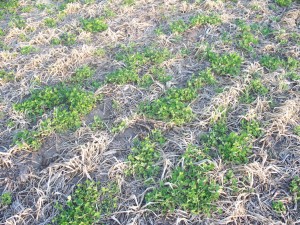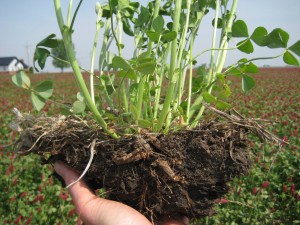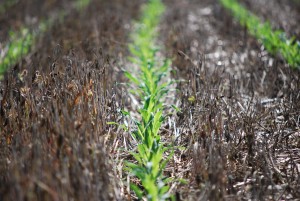“Planting this corn field was like planting into a garden” said my friend Dave. He has been a ‘cover cropper” for six years now. This year Dave no-tilled approximately 50% of his acres. Dave is one of the most innovative guys I know…but he’s also “cautious”; he does not want to lose money! That’s why Dave loves cover crops…using cover crops he has improved his profitability. In this photo diary we will look at photos from April, May and June where Dave had a cover crop consisting of Oats/GroundHog Cover Crop Radish/AU Robin Crimson Clover. The previous crop was corn.




What did the burndown consist of?
Due to the wet spring did you, or other cover crop users, notice if your fields with cover crops dried faster? That is one of the benefits we sell farmers on the use of cover crops, that your field will dry faster due to improved soil structure and plant uptake, did you find that to be correct?
Brett, Here is what Dave did on the burn down. “The chemical program that I used for the no-till corn following the cover crops of Oats, Groundhog Radish and Crimmson Clover and also the Austrian Winter Peas and Groundhog Radish was as follows. It was a burndown treatment done pre-emerge about 1 week before I started planting. 1. Used Verdict at 10 oz. / Acre. 2. Used 1 pint of MSO / Acre. 3. Used 1 lb. / acre of AMS. 4. Used 22 oz. / acre of Roundup Powermax. 5. Used 1 gallon / acre of SP1. I followed this treatment with a early post-emerge application of the following combinations. For the Austrian Winter Peas and Groundhog Radish fields and some of the Oats and Crimmson Clover fields, I used the following tank mix in this order. 1.Used .5 lbs. / acre of Atrazine 4L. 2. Used 3 oz. / acre of Laudis ( Bayer Crop Sciences Product ). 3. Used 1 pint / acre of MSO. 4. Used 1.5 lbs. / acre of AMS. 5. Used 1 Gallon / acre of SP1. For the Oats, Groundhog Radish , Crimmson Clover fields I had in Clinton County, I had used 2 Garst seed corn numbers that were Liberty Link hybrids. I used the following tank mix in this order. 1. Used 1.5 lbs. / acre of AMS. 2. Used 2 oz. / acre of Laudis. 3. Used 22 oz. / acre of Ignite 280 SL. 4. Used 1 Gallon / acre of SP1. This combination worked very well killing some of the crimmson clover that was slow in terminating from the burndown application. One of the other keys about using this tank mix is that you need to use more gallons / acre than normal and more tip pressure. I ran 17 Gallons / Acre and used about 60 lbs. of pressure. All of the other combinations that I gave you I ran 12.5 Gallons / Acre at about 50 lbs. of pressure. All of the corn following these cover crop combinations look excellent.”
If one plants winter rye is there ever an issue with ‘closing’ the furrow after the corn planter goes through the field? We run a 1250 Case IH planter with heavy duty closing disks.
Also looking at planting a cover crop for the first time. We have been no till for 20 plus years in south central NE. Will the cover crop grow on ground that has been corn on corn for years if applied by a plane, or do I need to drill it in? What about on soybean ground.
All help is appreciated.
Can I plant radishes and winter peas in wheat stubble that was sprayed with peak?
Dick, I’m confident that the Radishes will probably struggle. I know that when farmers plant turnips after having sprayed Peak they were very disappointed. I am not sure on the peas. Check with your chemical rep as they should know.